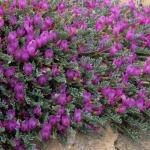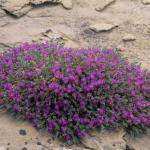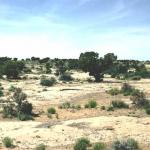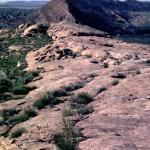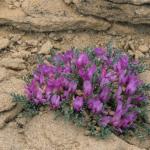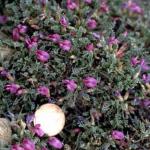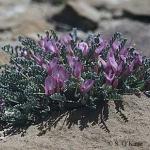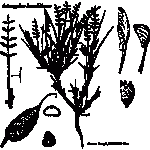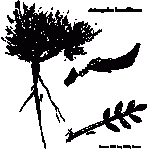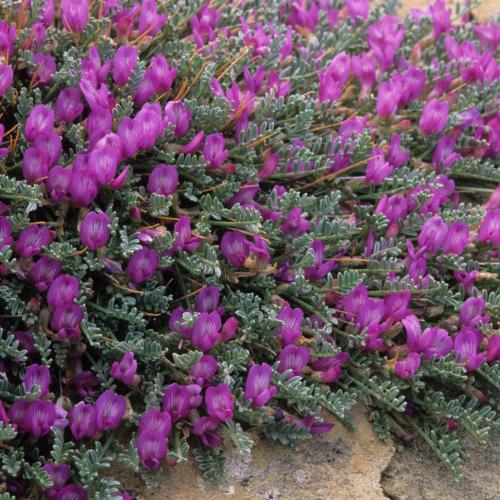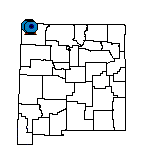Astragalus humillimus (Mancos Milkvetch)
TRAGACANTHA HUMILLIMA (A. GRAY) O. KUNTZE; PHACA HUMILLIMA (A. GRAY) RYDBERG
| USFWS | State of NM | USFS | BLM | Navajo Nation | State Rank | Global Rank | R-E-D Code | NMRPTC Status | Strategy Status |
|---|---|---|---|---|---|---|---|---|---|
| LE | E | GP 2 | S1 | G1? | 3-2-2 | R | SS |
| Overall Conservation Status | Documented Threats | Actions Needed |
|---|---|---|
| UNDER CONSERVED | Oil & gas development |
Status surveys on abundance, distribution and threats. Seed banking, possible reintroductions. Trend monitoring. |
Diminutive, tufted, strigulose perennial forming clumps up to 3 dm across; stems up to 1 cm long; leaves crowded, up to 4 cm long, odd-pinnate, leaflets 7-11, oblong-elliptic, 0.7-2.0 mm long, petiole and rachis forming persistent spines after fall of the leaflets; inflorescence a short raceme, 1-3 flowers; calyx about 3 mm long; corolla papilionaceous, lavander to purplish, a conspicuous lighter-colored spot in the throat of the corolla tube; fruit a legume, ovate, about 4.5 mm long, 2 mm wide, 4-9 seeds. Flowers late April and early May.
Astragalus gilensis, A. wittmanii, A. siliceus, and A. cremnophylax are all closely related, small, tufted, or mat-forming perennials, but in New Mexico only A. humillimus has persistent spinescent leaf stalks.
New Mexico, San Juan County; Colorado, Montezuma County; from Mancos Canyon, Colorado, southward to just south of the San Juan River in San Juan County, New Mexico.
Cracks or eroded depressions on sandstone rimrock ledges and mesa tops in Point Lookout sandstone, which is a Cretaceous sandstone that is part of the larger Mesa Verde stratigraphic series; 1,500-1,800 m (5,000-6,000 ft).
Astragalus humillimus was rediscovered near Farmington, New Mexico, in 1980. It was formerly known from only a single collection made in 1875. It is currently known from 16 sites in New Mexico, and 4 in Colorado. High mortality occurs during periods of extended drought.
The plants occur in an area of active oil and gas development. Populations are small and could be eliminated by energy development, road building, and other surface disturbance. The species appears to be in significant decline, rangewide, based on repeat surveys on the Navajo Nation, a 2020 status report from the BLM ACEC, and 30 year monitoring results. Declines are likely associated with climate change.
*New Mexico Native Plants Protection Advisory Committee. 1984. A handbook of rare and endemic plants of New Mexico. University of New Mexico Press, Albuquerque.
Barneby, R.C. 1964. Atlas of North American Astragalus. Memoirs of the New York Botanical Garden 13:1-1188.
Brandegee, T.S. 1876. Bulletin of the U.S. Geological Survey 23:235.
*U.S. Fish and Wildlife Service. 1989. Mancos milkvetch (Astragalus humillimus) recovery plan. U.S. Fish and Wildlife Service, New Mexico Ecological Services Field Office, Albuquerque, New Mexico.
Roth, D. 2020. 30-Year Monitoring report, Mancos milkvetch (Astragalus humillimus: Fabaceae). BLM Hogback Area of Critical Environmental Concern, San Juan County, NM 1990- 2020. Unpublished report prepared by the NM Energy, Minerals, and Natural Resources Department, Forestry Division, Santa Fe, NM, for the U.S. Fish & Wildlife Service, Region 2, Albuquerque, NM. http://www.emnrd.state.nm.us/SFD/ForestMgt/endangeredandrareplantreports.html
Roth, D. Status report. Mancos milkvetch (Astragalus humillimus). BLM Hogback ACEC. Unpublished report prepared by the NM Energy, Minerals, and Natural Resources Department, Forestry Division, Santa Fe, NM, for the U.S. Fish & Wildlife Service, Region 2, Albuquerque, NM. http://www.emnrd.state.nm.us/SFD/ForestMgt/endangeredandrareplantreports.html
For distribution maps and more information, visit Natural Heritage New Mexico

